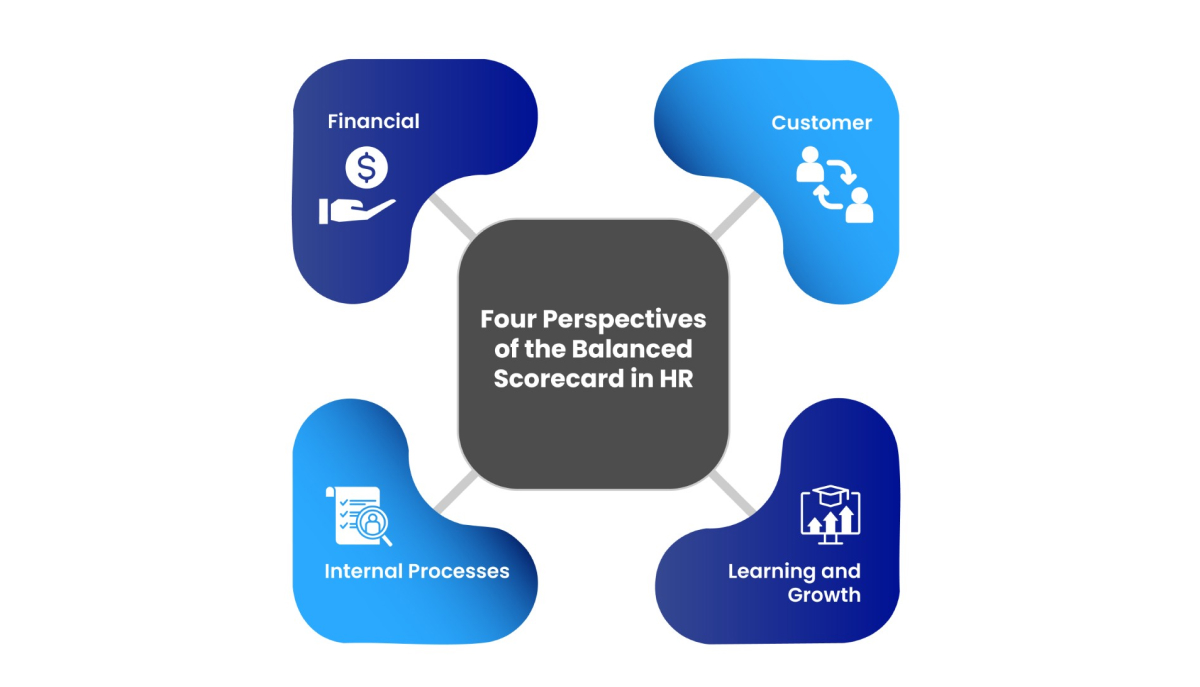
Startups are growing fast, and Human Resources (HR) plays a big role in their success from day one. A key tool for this is the Balanced Scorecard, which helps align people management with business goals in the early stages. This article explores what the Balanced Scorecard in HR means for startups, why it’s essential, and how to implement it effectively. With practical steps and insights tailored to startup needs, we’ll show how this tool can turn HR into a strategic driver of growth. Let’s dive into how startups can use it to build a strong foundation!
The balanced scorecard is a tool created by Robert Kaplan and David Norton to help companies turn their vision into clear actions. It evaluates performance beyond financial metrics, encompassing the effective integration of people, processes, and growth. For startups, this helps HR support the company’s big picture from the start, using four key areas to track progress, not just profits.
In HR, the balanced scorecard measures how well the team supports the company’s big picture. It uses four key areas to track success, not just numbers like profit. This helps HR show its value beyond hiring or payroll. With 78% of HR managers using tools like this for records, it’s clear this approach is growing.
For startups, the Balanced Scorecard (BSC) in HR transforms HR into a strategic partner from the very beginning. It connects people management to business goals, showing how employee efforts drive early growth. For example, it can measure the return on investment (ROI) of rapid training initiatives or track employee satisfaction; factors that directly influence productivity in a fast-paced startup environment.
Recent evidence reinforces its value. A 2024 hospital case study found that after phased implementation of a Balanced Scorecard, turnover dropped significantly, from 23.6% in 2015 to 3.4% in 2023. The reduction was attributed to better strategic alignment, clearer communication, and stronger employee engagement and trust.
Similarly, a 2024 systematic review of Balanced Scorecard implementation across low- and middle-income countries reported measurable improvements: staff training increased by 14.8% to 35.3%, patient satisfaction rose between 4% and 16%, and revenue generation improved by 0.1% to 1.83%, depending on context. These results demonstrate how using a Balanced Scorecard leads to tangible performance gains even in resource-constrained environments.
For startups, this means that HR can make data-driven decisions, align employee objectives with business priorities, and build a strong, transparent culture from the outset. The Balanced Scorecard not only improves accountability and communication but also ensures that every team member understands how their contribution supports the company’s growth trajectory.
The balanced scorecard looks at four areas to give a full picture of HR performance. Designed as a strategic framework by Kaplan and Norton in 1992, it helps HR align with business goals through a balanced approach. Here’s how each applies to startups:

1. Financial Perspective
This tracks the financial impact of HR on the startup. It looks at costs like turnover or the ROI of training. Reducing turnover by 10% saves money and supports growth. Startups can show investors how people's investments pay off with limited budgets.
2. Customer Perspective
In startups, customers are employees and early clients. This measures satisfaction, retention, and engagement. Happy employees work harder, and quick talent acquisition meets client demands. Listening to their needs helps HR support growth.
3. Internal Processes Perspective
This focuses on how well HR handles tasks like hiring or compliance. Efficient processes save time and money, critical for startups. Streamlining onboarding, for instance, speeds up team building in a lean setup.
4. Learning and Growth Perspective
This tracks skill development for the future. It measures training, career growth, and innovation. A strong learning culture prepares employees for rapid changes. HR ensures the startup team has skills to scale successfully.
These perspectives work together, giving startups a clear way to measure HR’s impact as they grow.
The Balanced Scorecard brings key benefits to startups. It improves planning by using data from all four perspectives, helping HR make smart choices with limited resources. This holistic view shows how finance, people, processes, and growth connect, vital for young companies.
It also measures performance better. Clear categories let HR see what works, like effective training, and adjust quickly. Sharing results with founders and investors builds trust, and data proves progress. In addition, it optimizes resources, ensuring time and money go to high-impact areas like talent.
A major plus is higher engagement. When HR uses this tool, employees feel supported, boosting morale in a startup’s high-pressure setting. With 73% of HR managers using AI for hiring, adding a Balanced Scorecard makes these efforts more focused.
The Balanced Scorecard helps startups track progress with lead and lag measurements, like customer service affecting ROI, and establishes a baseline to show growth to investors from the start.
Implementing a Balanced Scorecard requires a focused approach. Here’s a simple guide:

1. Outline Your Purpose
Start by understanding the startup’s big goals, like gaining customers or scaling fast. Share this vision with the HR team to align efforts. This purpose guides the process in a dynamic environment.
2. Create Specific Objectives and Measures
Set clear, measurable goals for each perspective. Aim to boost employee satisfaction by 5% or cut hiring costs by 10%. These targets keep the small team focused on key outcomes.
3. Map Each Perspective Strategically
Build a visual chart with columns for finance, customer, processes, and growth. Fill it with data like turnover rates or training hours. This map shows how everything connects, vital for a startup’s lean structure.
4. Analyze Performance
Review data to see HR’s progress. Check each perspective and the overall picture. This step highlights strengths, like quick hiring, and areas to improve, such as retention.
5. Share and Communicate Results
Present findings to founders, investors, and employees. A simple report builds trust and shows progress. Clear communication keeps the startup team aligned.
6. Develop Strategic Changes
Based on results, plan new ideas. Gather stakeholders to brainstorm changes that fit the startup’s vision. This ensures improvements support growth goals.
7. Implement the Changes
Put plans into action with team support. Explain why changes matter using Balanced Scorecard data. This helps everyone adapt to a fast-moving startup.
Regular reviews keep it effective, adjusting for new priorities or market shifts.
For startups, the right tools make the Balanced Scorecard easier. Software like Tune by Actio tracks goals and data, giving HR control with minimal staff. Dashboards offer a quick performance overview, perfect for busy founders.
Keep it simple: focus on 10-15 key objectives with one or two measures each. Test the plan with leadership to ensure it fits startup needs, like prioritizing culture over compliance. Align it with the company’s style using familiar language. Regular check-ins and feedback keep it on track.
Startups can use the Balanced Scorecard’s four perspectives, financial outcomes, customer outcomes, process improvement outcomes, and learning and growth outcomes, to set 2-6 objectives per area, creating a dozen key actions. This balances shareholder needs with customer and enterprise goals, ideal for early strategy.
The Balanced Scorecard in HR delivers results for startups. A tech startup optimized its hiring process, cutting costs by 15% with targeted recruitment, showing financial gains. Another e-commerce firm boosted engagement by 20% with skill-based training, driving teamwork.
In startups, this tool supports lean operations. It helps attract skilled talent quickly while building a collaborative culture. With 77% of HR managers using it for payroll, it proves effective across tasks. Startups also see improved retention when training aligns with growth goals, making it a driver of early success.
Google’s early HR strategy mirrored the Balanced Scorecard framework. Its “People Operations” team linked people metrics directly to business results:
By aligning HR data with company goals, Google turned culture and talent into measurable growth drivers, a model startup can replicate on a smaller scale with clear goals and regular performance tracking.
Startups face unique hurdles with the Balanced Scorecard. Gathering accurate data takes time, and gaining buy-in from a small, diverse team can be tough, especially with differing priorities. Some may resist if they don’t see immediate value.
Start with a small pilot project and set achievable goals to show early wins. Bring in a Data Protection Officer for guidance and compliance, building trust. Regular updates, hands-on training, and open communication help the team adapt. With dedication, these challenges turn into growth opportunities for a startup’s HR strategy.
Startups benefit from writing a business strategy early, as it exposes unresolved questions and vague plans. The Balanced Scorecard’s common vocabulary, understood by many, eases adoption and aligns HR with startup ambitions.
As startups grow, the Balanced Scorecard will adapt. With HR analytics, it can offer deeper insights into talent needs. New market trends may require tweaks, but its core, aligning people with strategy, remains strong.
Startups leading with this approach will excel in talent management and performance. By staying flexible and data-driven, HR can shape a future where people and profits grow together, especially in the startup phase.
The Balanced Scorecard in HR is a game-changer for startups, aligning people management with growth goals from the start. It measures success across finance, customer needs, processes, and learning, turning HR into a strategic partner. With steps like setting objectives, mapping perspectives, and reviewing results, startups build a roadmap for success.
By overcoming challenges and using tailored tools, HR can prove its value with data, boosting engagement and efficiency. For startups in their first 90 days or beyond, now is the time to adopt this approach and unlock HR’s full potential.

CredBadge™ is a proprietary, secure, digital badging platform that provides for seamless authentication and verification of credentials across digital media worldwide.
CredBadge™ powered credentials ensure that professionals can showcase and verify their qualifications and credentials across all digital platforms, and at any time, across the planet.

Please enter the License Number/Unique Credential Code of the certificant. Results will be displayed if the person holds an active credential from TMI.